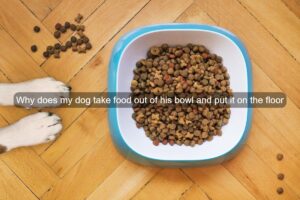As a pet parent, dealing with your dog’s poop may seem gross. But a healthy poop means a healthy dog. A healthy dog poop chart demonstrates the ideal color, consistency, and content of the poop. Understanding it is essential to determine whether your dog is experiencing any health issues.
The four Cs of dog poop are:
- Consistency
- Color
- Contents
- Coating
(You’ll learn more about them in the later sections of this article.)
A change or abnormality in your dog’s food, environment, or general health is frequently associated with abnormal Cs. For example, if your dog eats something to which he is allergic, he will have diarrhea right away. You can infer from the watery consistency of his stool that there has been a problem with his diet regimen.
Let’s get a quick review of the unhealthy dog poop chart. So, after comparing it to the healthy dog poop chart, you can spot any problems with your puppy right away.
What Does Healthy Dog Poop Look Like?
The poop of a healthy dog is semi-solid but has a definite form. It has the consistency of play-doh and holds its shape even when picked up. It is soft and tubular, having the shape of a log. Normal poop has any shade of brown, be it dark, or light. The poop of a completely healthy pup is always chocolate brown in color. It doesn’t have any visible particles in it. Sometimes the undigested matter is present in small amounts. Healthy poop is not covered in a layer of mucus and does not leave any residue behind when picked up.
Unhealthy Dog Poop Chart
Poop Characteristics |
Healthy Poop |
Unhealthy Poop |
|
Shape and volume |
Formed, log-shaped, 1 to 3 times per day |
Deformed or hard pellets, more than three times per day |
|
Consistency |
Semi-solid, soft, firm, retains shape when picked up |
Either hard or runny/formless |
|
Color |
Chocolate brown (Perfect) Any shade of brown, from light to dark |
Pink/purple, green, yellow-orange, grey, black, or white |
|
Contents |
Homogeneous or sometimes small amounts of undigested matter |
Worms (visible roundworms or rice-shaped segments of tapeworms), blood, grass, hair, or pieces of non-edible stuff (for example, plastic) |
|
Coating |
No coating of mucus, only a little mucus is present |
Coating of mucus, poop leaves residue behind when picked up |
|
Smell |
Usual smell |
A pungent smell, which is hard to bear |
The 4 Cs of Dog Poop
The four Cs of dog poop are consistency, color, contents, and coating. These are the main parameters that vets use to assess the health of dogs based on their feces. Let’s see what these 4 Cs in an unhealthy dog poop chart indicate.
1. Consistency
A dog’s poop consistency is affected by his diet type and daily intake. Dry pet food has additives and fillers which cause your dog to excrete more liquidy and smelly poop, whereas a raw diet makes dogs excrete more solid feces.
An unhealthy dog is likely to produce two types of feces, either runny or hard. Watery and formless poop is an indication of diarrhea. It is usually a result of consuming food that the dog is allergic to or due to colitis. Some parasitic and bacterial infections of the gastrointestinal tract also result in diarrhea.
A firm and hard poop is an indication of constipation. It may be the result of dehydration, a diet lacking in dietary fiber, or some other digestive disease. So, if you note your dog’s poop consistency to be abnormal, give him some vet-approved probiotics, engage him in a walk, or consult your vet.
2. Color
The color of your dog’s poop is another visual parameter to define his health. If it is of any color other than brown, there are two possibilities; either your dog has eaten something pigmented (for example, beets or grass), or he has a disease.
Here are what some poop colors mean:
- Pink or Red
Fresh red or pink color in poop shows a hemorrhage, especially of the hindgut. There’s been an infection or injury to the intestine causing it to bleed. Hemorrhagic gastroenteritis needs an immediate veterinary checkup.
- Black
The blood will eventually turn black if the dog has a hemorrhage in the foregut. A portion of the contents is digested, while the remainder appears as black poo.
- Green
Green poop may be due to different reasons. It is either because the dog is eating too much grass or because of an intestinal infection, liver dysfunction, parasites, gallbladder disease, etc.
- Yellow-orange
Yellow-orange colored poop indicates liver and bile issues along with indigestion. The bile pigment bilirubin goes undigested through the tract and imparts the yellowish orange color to the poop.
- Grey
A grey and greasy stool is a sign of fat malabsorption. Either the dog is consuming too much fat or the fats are not being properly emulsified by the liver and gallbladder.
- White
White poop comes out when your dog eats too many foods containing calcium in them.
3. Contents
The contents which should be looked for in an unhealthy poop are:
- Worms
If the dog has not been dewormed, you may see some dog worms in his poop. Sometimes thin roundworms are present, and other times you can see rice-shaped segments of tapeworms.
- Large amounts of undigested matter
When a dog’s digestive system is not working properly, you may find large amounts of undigested matter in his poop.
- Blood
Visible blood streaks in a dog’s poop are a sign of a severe infection or intestinal trauma.
- Hair
If your furry friend has been under stress lately, he will over-groom himself. It will result in a lot of hair in his poop. If left unnoticed, it leads to blockage of the intestines, a condition called trichobezoar.
- Random stuff
Dogs have the habit of eating everything. They tend to chew non-edible stuff too. Therefore, it’s possible that dog poop has bits of plastic or clothes in it.
Sometimes the grass is also present in fairly large amounts.
4. Coating
A coating on the outside of the feces that resembles mucus or slime and leaves behind a residue when picked up is a major indicator of an unhealthy pooch. It mostly refers to intestinal irritation, food allergies, or infections. If there is blood present along with the mucus coating, it may be a symptom of colitis, the inflammation of the large intestine.
Final Thoughts on Unhealthy Dog Poop Chart
According to the healthy dog poop chart, a dog’s stool should be semi-solid, firm, tubular, and brown in color. It should be homogeneous with no contents and no coating. But, if you notice any of the above “Cs” are not normal, as in the unhealthy dog poop chart, it’s time to be alert. Take your puppy to the vet and get him diagnosed as early as possible.





